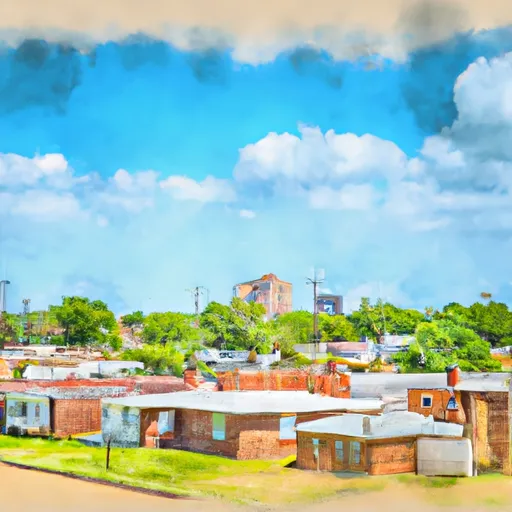-
 Snoflo Premium
Snoflo Premium
Get unlimited access to all our content
With no Ad interruptions! - Start Your Free Trial Login with existing account
Ringwood
Eden Index
Climate
8.3
•
Recreation
0.3
•
Community
1.7
•
Safeguard
3.8/10

Ringwood, Oklahoma is a small town located in Major County, in the central part of the state. With a population of approximately 500 people, it offers a close-knit community atmosphere. The climate in Ringwood is classified as humid subtropical, characterized by hot summers and mild winters. Average temperatures range from the mid-90s°F (mid-30s°C) in the summer to the mid-40s°F (around 7°C) in the winter.
Hydrology constituents in the area primarily consist of the North Canadian River, which flows just south of the town. It provides a source of water for various outdoor activities and supports the local wildlife habitat. The river also attracts fishing enthusiasts, with species like catfish, bass, and crappie being commonly caught.
For outdoor recreation, Ringwood is surrounded by picturesque landscapes, making it an excellent destination for nature lovers. Boating, canoeing, and kayaking are popular water activities on the river. Additionally, there are opportunities for hiking, camping, and birdwatching in the nearby Alabaster Caverns State Park and Little Sahara State Park. These parks offer unique experiences, from exploring the largest natural gypsum cave in the world to sand dune adventures and wildlife encounters.
In conclusion, Ringwood, Oklahoma boasts a pleasant climate, access to the North Canadian River, and numerous outdoor recreation opportunities, making it an attractive destination for those seeking outdoor adventures and a tight-knit community ambiance.
What is the Eden Index?
The Snoflo Eden Index serves as a comprehensive rating system for regions, evaluating their desirability through a holistic assessment of climate health, outdoor recreation opportunities, and natural disaster risk, acknowledging the profound impact of these factors on livability and well-being.
Climate Health Indicator (CHI): 8.3
Ringwood receives approximately
771mm of rain per year,
with humidity levels near 81%
and air temperatures averaging around
15°C.
Ringwood has a plant hardyness factor of
7, meaning
plants and agriculture in this region tend to thrive during the non-winter months.
By considering the ideal temperature range, reliable water supplies, clean air, and stable seasonal rain or snowpacks, the Climate Health Indicator (CHI) underscores the significance of a healthy climate as the foundation for quality living.
A healthy climate is paramount for ensuring a high quality of life and livability in a region, fostering both physical well-being and environmental harmony. This can be characterized by ideal temperatures, reliable access to water supplies, clean air, and consistent seasonal rain or snowpacks.
Weather Forecast
Streamflow Conditions
Lower Cimarron
Area Rivers
Lower Cimarron
Snowpack Depths
Lower Cimarron
Reservoir Storage Capacity
Lower Cimarron
Groundwater Levels
Recreational Opportunity Index (ROI): 0.3
The Recreational Opportunity Index (ROI) recognizes the value of outdoor recreational options, such as parks, hiking trails, camping sites, and fishing spots, while acknowledging that climate plays a pivotal role in ensuring the comfort and consistency of these experiences.
Access to outdoor recreational opportunities, encompassing activities such as parks, hiking, camping, and fishing, is crucial for overall well-being, and the climate plays a pivotal role in enabling and enhancing these experiences, ensuring that individuals can engage in nature-based activities comfortably and consistently.
Camping Areas
| Campground | Campsites | Reservations | Toilets | Showers | Elevation |
|---|---|---|---|---|---|
| Cherokee City RV Park | 16 | 1,180 ft | |||
| Fort Cobb - Area 1 | None | 1,359 ft | |||
| Fort Cobb - Area 4 | None | 1,364 ft | |||
| Fort Cobb - Area 2 | None | 1,360 ft | |||
| Randlett Park | None | 1,192 ft | |||
| Fort Cobb - Area 5 | None | 1,380 ft | |||
| Lake Chickasha | 50 | 1,207 ft | |||
| Cleo Springs RV Park | None | 1,275 ft | |||
| Roman Nose State Park | None | 1,455 ft | |||
| Fort Cobb - Area 3 | None | 1,378 ft |
Nearby Fishing
Nearby Ski Areas
Catastrophe Safeguard Index (CSI):
The Catastrophe Safeguard Index (CSI) recognizes that natural disaster risk, encompassing floods, fires, hurricanes, and tornadoes, can drastically affect safety and the overall appeal of an area.
The level of natural disaster risk in a region significantly affects safety and the overall livability, with climate change amplifying these risks by potentially increasing the frequency and intensity of events like floods, fires, hurricanes, and tornadoes, thereby posing substantial challenges to community resilience and well-being.
Community Resilience Indicator (CRI): 1.7
The Community Resilience Indicator (CRI) recognizes that education, healthcare, and socioeconomics are crucial to the well-being of a region. The CRI acknowledges the profound impact of these elements on residents' overall quality of life. By evaluating educational resources, healthcare accessibility, and economic inclusivity, the index captures the essential aspects that contribute to a thriving community, fostering resident satisfaction, equity, and social cohesion.

